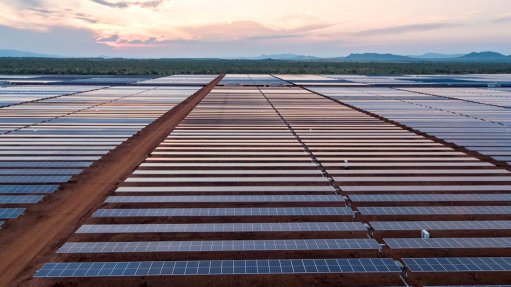Mondi builds structure using 100% composite material with 100% local content
Mondi Richards Bay, refurbishing its chemical plant over the past 18 months, has erected a complex and demanding structure using 100% composite material with 100% local content, a first for a chlor-alkali plant in South Africa.
The plant, which is responsible for the production of caustic soda, used as a raw material in the production of pulp – the building block in the paper manufacturing process – has now been commissioned according to schedule and is operating at the desired parameters, says Mondi project lead mechanical engineer Francois Martens.
Caustic soda production is critical for Mondi South Africa, which is a leading integrated producer of pulp, paper and board in the country.
“Mondi Richards Bay is unique in operating its own integrated chemical plant to produce its own key chemicals for pulp production, compared with many other pulp mills that procure in most of their process chemicals from the open market. Chemically pure hydrochloric acid, as well as sodium hypochlorite, as by-product to the caustic soda produced, is also produced on site to serve the local South African and African markets.”
A key area of the project, which started with Mondi’s launch of its ‘Chemical Plant Rebuild Project’ in February 2020, was the construction of a new supportive structure hosting the complex equipment required for the electrolytic process that produces sodium hydroxide from purified dissolved salt.
According to Martens, the entire system previously comprised electrolytic cells, busbars and adjacent pipelines supported by a solid concrete base, reinforced with steel rebars and installed on a concrete foundation.
Owing to the age of the plant, and aggravated by an inherently corrosive chemical plant environment, the old support structure had reached the end of its useful life.
Following the launch of the Chemical Plant Rebuild Project to replace or refurbish equipment and parts in key plant areas, which included primary brine treatment, secondary brine treatment (brine ion exchange), piping systems and associated components and chlor-alkali and sodium chlorate electrolysis, as well as associated utilities areas, a comprehensive material analysis was undertaken.
This was done using a scoring system designed to adequately establish the optimum material of construction (MoC) for pipelines and adjacent equipment, as well as the supportive structure for the chlor-alkali electrolysis area.
The chlor-alkali concrete structure was initially earmarked for extensive rehabilitation; however, owing to its advanced degradation, amid corrosion and structurally compromised concrete, a subsequent decision was made to rebuild the structure in the same location in the plant during an extended mill maintenance shutdown in late 2021.
The in-depth analysis of a wide variety of potential MoCs established the inadequacy of conventional materials, such as concrete and steel, when in contact with aggressive chemical environments, which disqualified them from future consideration.
Recognising the advances made in material science and supported by the findings of the scoring system, Mondi embraced novel concepts with regard to materials and design to ensure long-term performance of the structures and pieces of equipment installed in the plant, and it was proposed that consideration be given to the use of alternative MOCs to concrete, designed and manufactured to meet all the structural requirements in a very corrosion-challenging plant environment.
The resultant supportive structure for the electrolytic cells and adjacent equipment was built to a specific design, based on recognised standards and design codes, to meet all the requirements of strength and corrosion resistance that it will be subject to during its service life.
The components making up the supportive structure, from the load-bearing beams down to the finest profiles, are made of 100% non-metallic composite material, comprising glass-reinforced plastic (GRP) and a Bisphenol-A vinyl ester resin (VER), using a highly specialised manufacturing method called ‘pultrusion’.
“This manufacturing method allows a unique resin:fibreglass ratio of 30% to 70%, which, in turn, affords the composite its extreme mechanical strength, while the resin component, the VER, confers its chemical resistance,” Martens comments.
Mondi selected the locally made brand Dion 9133 VER, the manufacturing process of which South Africa’s largest resin manufacturer and Reichhold-US licensee, NCS Resins, has been perfecting since 2008.
The manufacturing technology for VER is highly specialised, following a very intricate and complex production process that only a few resin manufacturers have access to worldwide.
In 2008, NCS Resins embarked on a complex cooperation for the implementation of the Dion VER manufacturing technology in the company’s Durban-based plant, becoming the only VER manufacturer in Africa.
Prior to this, all the VER requirements for the South African composite industry, particularly the corrosion market, were exclusively based on imported product.
Meanwhile, Martens further explains that GRP pultruded profiles are much lighter than steel and their resistance to corrosion gives them extended longevity with minimal, if any, maintenance work throughout their service life.
“These components alone make GRP pultruded profiles a significantly more economical option to steel or concrete.”
The structure supports a total of 72 t – comprising a 36 t load on each side – at any given time, made up of the actual electrolytic cells and the adjacent components.
Each side is made up of dedicated platforms, designed to hold three cells each, at 3.3 t for each cell, and designed to support 9.9 t, as well as the adjacent equipment.
All the walkways consist of gratings, also made in composite material based on a corrosion-resistant VER.
In the GRP industry worldwide, VER gratings are made in an orange colour, to differentiate them from gratings made in polyester resins that are not corrosion resistant, he adds.
“From the outset, designing this structure in GRP was extremely challenging in its complexity, as the final product did not only have to meet strict structural requirements, but it also had to demonstrate long-term corrosion resistance, owing to continuous exposure to an aggressive plant environment,” Martens continues.
If such a development was possible, and with such success for a process plant in the chemicals industry, not only is the same possible for other industries, lacking the corrosive component, but it will be a real encouragement for those industries to follow suit.”
In its design and execution, the Mondi structure sets a “very high bar” as far as standards and expectations are concerned.
Despite the challenges presented by Covid-19 from the start of 2020, work on the project continued, mostly through virtual meetings and discussions, and with extremely restricted and very limited presence on site, the project came to fruition during the recent extended mill shutdown from September to December 2021.
The structure, manufactured during the course of 2021, was completed in August, assembled off site in a ‘dry run’ to verify all the detailed engineering, tolerances and fittings, besides others.
Subsequent to the dry run, the structure was once again dismantled, packed and transported to Mondi Richards Bay for assembly on site.
Comments
Press Office
Announcements
What's On
Subscribe to improve your user experience...
Option 1 (equivalent of R125 a month):
Receive a weekly copy of Creamer Media's Engineering News & Mining Weekly magazine
(print copy for those in South Africa and e-magazine for those outside of South Africa)
Receive daily email newsletters
Access to full search results
Access archive of magazine back copies
Access to Projects in Progress
Access to ONE Research Report of your choice in PDF format
Option 2 (equivalent of R375 a month):
All benefits from Option 1
PLUS
Access to Creamer Media's Research Channel Africa for ALL Research Reports, in PDF format, on various industrial and mining sectors
including Electricity; Water; Energy Transition; Hydrogen; Roads, Rail and Ports; Coal; Gold; Platinum; Battery Metals; etc.
Already a subscriber?
Forgotten your password?
Receive weekly copy of Creamer Media's Engineering News & Mining Weekly magazine (print copy for those in South Africa and e-magazine for those outside of South Africa)
➕
Recieve daily email newsletters
➕
Access to full search results
➕
Access archive of magazine back copies
➕
Access to Projects in Progress
➕
Access to ONE Research Report of your choice in PDF format
RESEARCH CHANNEL AFRICA
R4500 (equivalent of R375 a month)
SUBSCRIBEAll benefits from Option 1
➕
Access to Creamer Media's Research Channel Africa for ALL Research Reports on various industrial and mining sectors, in PDF format, including on:
Electricity
➕
Water
➕
Energy Transition
➕
Hydrogen
➕
Roads, Rail and Ports
➕
Coal
➕
Gold
➕
Platinum
➕
Battery Metals
➕
etc.
Receive all benefits from Option 1 or Option 2 delivered to numerous people at your company
➕
Multiple User names and Passwords for simultaneous log-ins
➕
Intranet integration access to all in your organisation


















